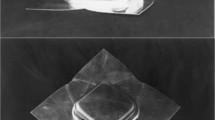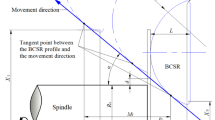Abstract
In the die-less spinning of the conical part, the forming state changes during the spinning process and depends on the forming parameters, which has a critical effect on the forming quality of the spun part. In this paper, a criterion of the forming states is established, and its dependence on the forming parameters is investigated. It is found that the formed wall thickness changes during die-less spinning. According to the formed wall thickness variation degree, three forming states are defined: shear spinning state (\({t}_{f}={t}_{0}sin\alpha\), where \({t}_{0}\) and \({t}_{f}\) are the initial and formed wall thicknesses, respectively, and \(\alpha\) is half-cone angel), the conventional spinning state (\({t}_{f}>0.9{t}_{0}\)), and transition state between the shear and conventional spinning states (\({t}_{0}sin\alpha <{t}_{f}\le 0.9{t}_{0}\)). The distribution of stress and strain in three forming states is obviously different. The die-less spinning always proceeds in the sequence of shear spinning state, transition state, and conventional spinning state. The initial forming state may be any one of them, which is mainly determined by the diameters of the blank and general mandrel. Thus, the quantitative dependence of initial forming state on the diameters of blank and general mandrel is further analyzed, and a criterion for the initial forming state is correspondingly established. In addition, the influence of forming parameters, including the blank parameters, mold parameters, and process parameters, on the criterion for the initial forming state in die-less spinning is revealed. This paper could improve the understanding of the deformation mechanism in die-less spinning.




















Similar content being viewed by others
Data availability
Not applicable.
References
Kwiatkowski L, Tekkaya AE, Kleiner M (2013) Fundamentals for controlling thickness and surface quality during dieless necking-in of tubes by spinning. CIRP Ann 62(1):299–302. https://doi.org/10.1016/j.cirp.2013.03.054
Xia QX, Xiao GF, Long H, Cheng XQ, Sheng XF (2014) A review of process advancement of novel metal spinning. Int J Mach Tool Manufact 85:100–121. https://doi.org/10.1016/j.ijmachtools.2014.05.005
Music O, Allwood JM, Kawai K (2010) A review of the mechanics of metal spinning. J Mater Process Technol 210(1):3–23. https://doi.org/10.1016/j.jmatprotec.2009.08.021
Wang CH, Liu KZ, Zhou L (2017) Xuan Ya Ji Shu (in Chinese). Fujian Science and Technology Publishing House, Fuzhou
Sugita Y, Arai H (2014) Formability in synchronous multipass spinning using simple pass set. J Mater Process Technol 217:336–344. https://doi.org/10.1016/j.jmatprotec.2014.11.017
Zhang JH, Zhan M, Yang H, Jiang ZQ, Han D (2012) 3D-FE modeling for power spinning of large ellipsoidal heads with variable thicknesses. Comp Mater Sci 53(1):303–313. https://doi.org/10.1016/j.commatsci.2011.08.010
Guo H, Wang J, Lu GD, Sang ZH, Wang QH (2017) A study of multi-pass scheduling methods for die-less spinning. J Zhejiang Univ - Sci 18(6):413–429. https://doi.org/10.1631/jzus.A1600403
Gao PF, Yan XG, Li FG, Zhan M, Ma F, Fu MW (2022) Deformation mode and wall thickness variation in conventional spinning of metal sheets. Int J Mach Tool Manufact 173:103846. https://doi.org/10.1016/j.ijmachtools.2021.103846
Wang L, Long H (2013) Roller path design by tool compensation in multi-pass conventional spinning. Mater Des 46:645–653. https://doi.org/10.1016/j.matdes.2012.10.048
Li ZX, Shu XD (2019) Numerical and experimental analysis on multi-pass conventional spinning of the cylindrical part with GH3030. Int J Adv Manuf Technol 103(5–8):2893–2901. https://doi.org/10.1007/s00170-019-03767-2
Tokuhiro S, Suzuki N, Takeuchi O (2018) Cylinder forming by die-less shear spinning with sheet thickness controlling of its wall. Procedia Manuf 15:1232–1238. https://doi.org/10.1016/j.promfg.2018.07.364
Gondo S, Arai H, Kajino S, Nakano S (2021) Evolution of strain state of a rolled aluminum sheet in multi-pass conventional spinning. J Manuf Sci Eng Trans ASME 143(6):061011. https://doi.org/10.1115/1.4049476
Bai DN, Gao PF, Yan XG, Wang Y (2021) Intelligent forming technology: state-of-the-art review and perspectives. J Adv Manuf Sci Technol 1(3):2021008. https://doi.org/10.51393/j.jamst.2021008
Chen SW, Gao PF, Zhan M, Ma F, Zhang HR, Xu RQ (2018) Determination of formability considering wrinkling defect in first-pass conventional spinning with linear roller path. J Mater Process Technol 265:44–55. https://doi.org/10.1016/j.jmatprotec.2018.10.003
Kang DC, Wang ZR, Li SD, Cheng QM (1985) Spinning of cone without mandrel (in Chinese). China Metal Form Eq Manuf Technol 03:13–17
Kang DC, Wang ZH (1999) Study on deformation mode of conventional spinning of plates. J Mater Process Technol 91(1–3):226–230. https://doi.org/10.1016/S0924-0136(98)00447-6
Funding
This work was supported by the National Key R&D Program of China (Grant number 2020YFA0711100), the National Natural Science Foundation of China (Grant numbers 92060107 and 51875467) and the National Science and Technology Major Project (Grant number J2019-VII-0014–0154).
Author information
Authors and Affiliations
Contributions
Xinggang Yan: conceptualization, methodology, investigation, experiments, software, writing—original draft. Mei Zhan: writing—review and editing, supervision, project administration, funding acquisition. Yao Wang: investigation, experiments, resources. Pengfei Gao: conceptualization, supervision, writing—review and editing, funding acquisition. Yongdi Wang: software, data curation.
Corresponding authors
Ethics declarations
Ethical approval
Not applicable.
Consent to participate
Not applicable.
Consent for publication
All the authors have read and agreed to the published version of the manuscript.
Competing interests
The authors declare no competing interests.
Additional information
Publisher's note
Springer Nature remains neutral with regard to jurisdictional claims in published maps and institutional affiliations.
Rights and permissions
Springer Nature or its licensor (e.g. a society or other partner) holds exclusive rights to this article under a publishing agreement with the author(s) or other rightsholder(s); author self-archiving of the accepted manuscript version of this article is solely governed by the terms of such publishing agreement and applicable law.
About this article
Cite this article
Yan, X., Zhan, M., Wang, Y. et al. Criterion and processing-dependence of forming states in the die-less spinning of conical part. Int J Adv Manuf Technol 125, 3037–3051 (2023). https://doi.org/10.1007/s00170-023-10867-7
Received:
Accepted:
Published:
Issue Date:
DOI: https://doi.org/10.1007/s00170-023-10867-7




